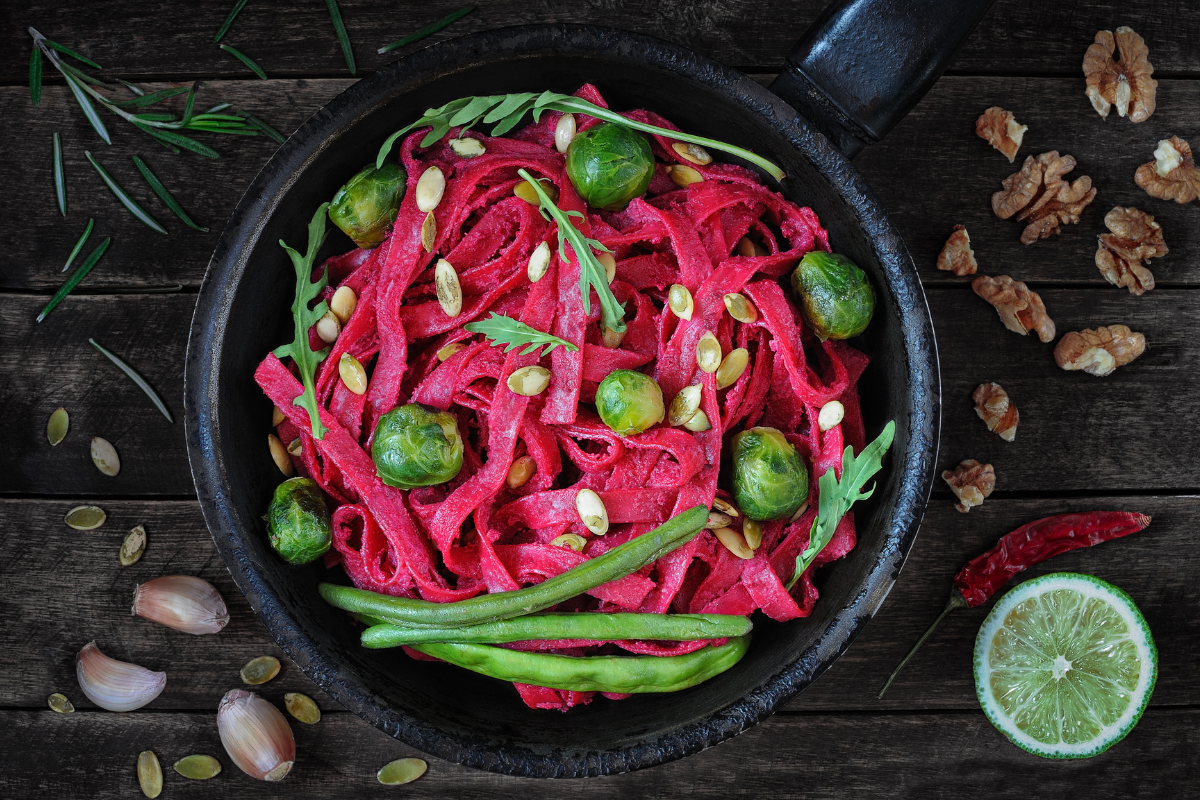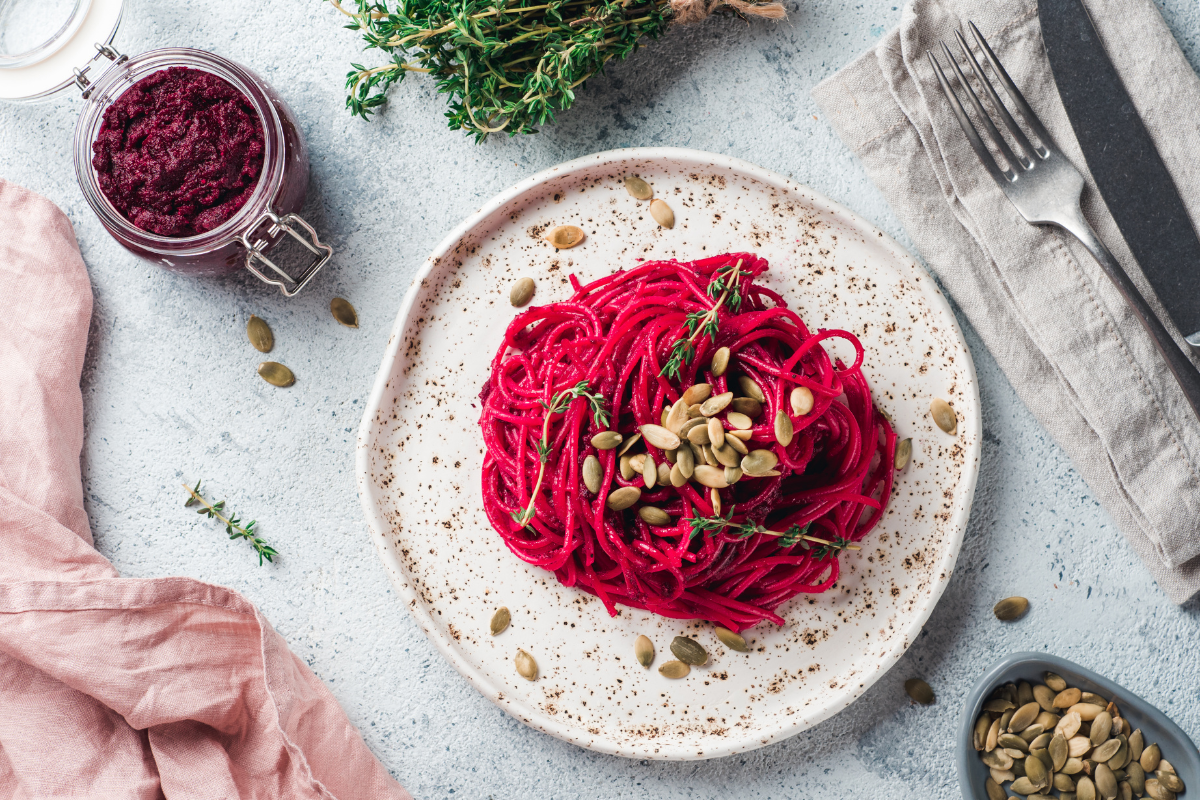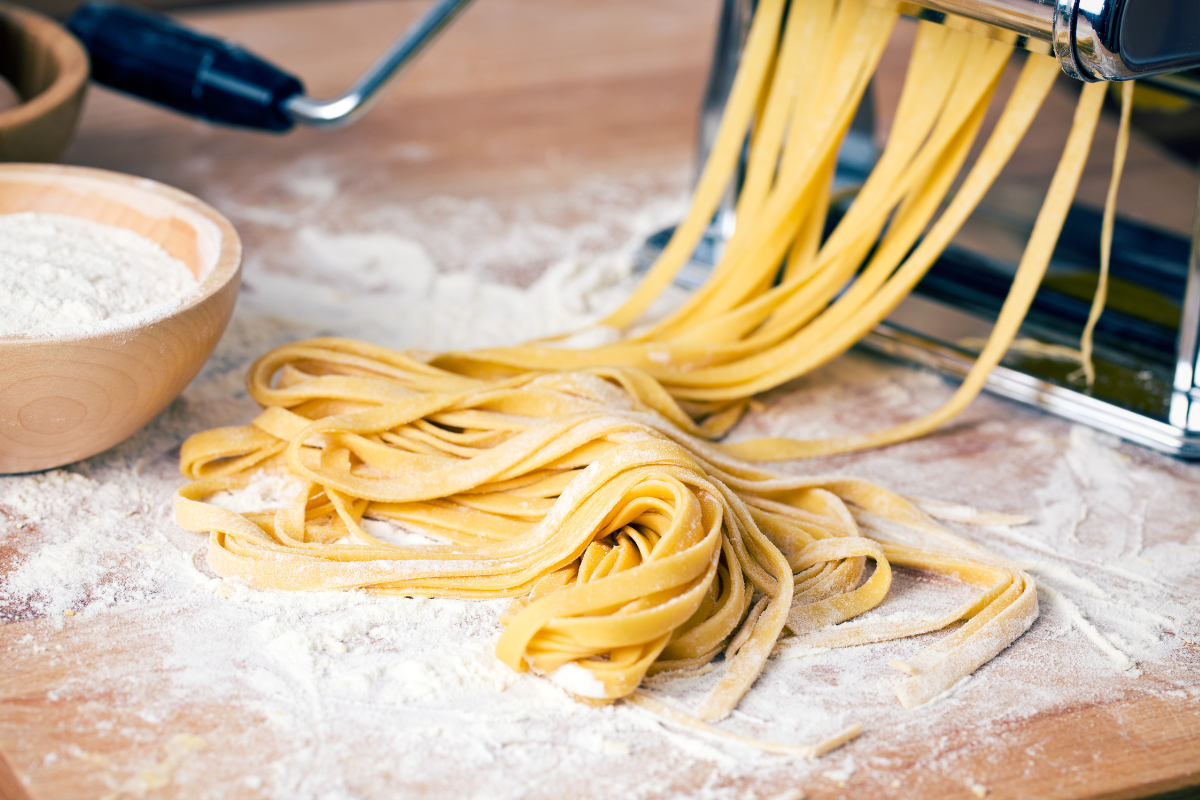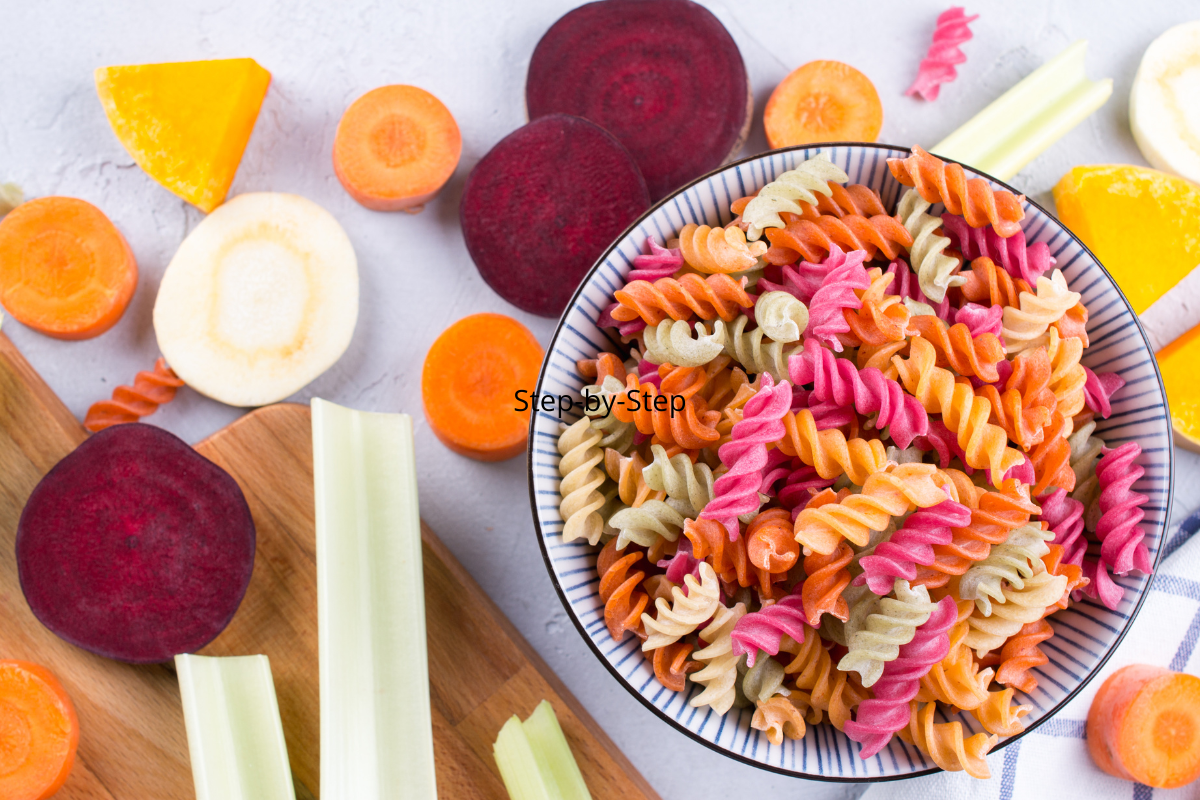Introduction to Beet Pasta
Imagine a plate of pasta that not only tantalizes your taste buds but also serves as a feast for the eyes. That’s the magic of beet pasta. This dish combines the earthy sweetness of beets with the comforting texture of pasta, creating a meal that’s as nutritious as it is beautiful.
What is Beet Pasta?

Beet pasta is a homemade pasta dough infused with pureed beets, giving it a vibrant, natural pink hue and a subtle, sweet flavor. This twist on traditional pasta incorporates the nutritional powerhouse of beets, making it a healthier option that doesn’t skimp on taste or presentation.
Why You Should Try Beet Pasta recipe
For starters, it’s a fantastic way to sneak more vegetables into your diet, especially if you’re cooking for those who might be a bit picky about their greens (or reds, in this case). Moreover, making pasta from scratch is a rewarding experience. It connects you with your food in a way that store-bought pasta just can’t match. Plus, the striking color of beet pasta is sure to impress guests and elevate any dinner to a special occasion.
So, why not roll up your sleeves and dive into the world of homemade beet pasta? With a bit of patience and creativity, you’re not just making dinner; you’re crafting an edible masterpiece. Let’s embark on this culinary adventure together, exploring the steps to create your very own beet pasta from the comfort of your kitchen.
Health Benefits and Nutritional Value
Diving into the world of beet pasta, it’s not just the vibrant color that makes this dish stand out—it’s also the plethora of health benefits packed in every bite. Beets, the star ingredient, are not only responsible for the pasta’s eye-catching hue but also bring a wealth of nutritional benefits to the table.
nutritional benefits of beets….read more
Nutritional Components of Beets
Beets are a treasure trove of vitamins, minerals, and antioxidants. They’re rich in vitamin C, fiber, and essential minerals like potassium, which supports nerve and muscle function, and manganese, crucial for bone health and metabolic processes. Beets are also high in nitrates, compounds that can improve blood flow and lower blood pressure, enhancing cardiovascular health.
For those curious about the myriad health benefits of beets, a deeper dive into their impact can be found in this detailed Healthline article, which covers how beets contribute to improved health and well-being.
Benefits of Homemade Pasta
Opting for homemade pasta, especially when it’s infused with the goodness of beets, means you’re choosing a meal that’s free from the preservatives and additives often found in store-bought versions. This not only makes your dish healthier but also allows you to control the quality and quantity of ingredients used, tailoring the recipe to suit dietary needs and preferences.
Moreover, the process of making pasta from scratch is a mindful activity that can reduce stress. The act of kneading the dough and shaping the pasta can be incredibly therapeutic, offering a sense of accomplishment that you just can’t get from a box.
Incorporating beet pasta into your diet is a delicious way to boost your intake of essential nutrients while enjoying a meal that’s both satisfying and visually appealing. Whether you’re looking to impress dinner guests or simply treat yourself to a nutritious and delicious meal, beet pasta ticks all the boxes. So, let’s move on to what you’ll need to bring this dish to life in your own kitchen.
Cooking and Serving
After crafting your beautiful beet pasta, the next steps bring you closer to enjoying this delightful dish. Cooking pasta might seem straightforward, but a few tips can elevate your meal from good to gourmet. Let’s explore how to perfectly cook your pasta and pair it with sauces that complement its unique flavor.
Cooking the Pasta
- Boil Water: Fill a large pot with water, add a generous amount of salt, and bring it to a rolling boil. The salt enhances the pasta’s flavor, so don’t skimp on it!
- Cook the Pasta: Gently add your beet pasta to the boiling water. Since fresh pasta cooks much quicker than dried, it will only need 2-4 minutes, depending on thickness. Stir occasionally to prevent sticking.
- Test for Doneness: Start tasting the pasta after two minutes. You’re aiming for al dente—firm to the bite but cooked through. Once ready, reserve a cup of pasta water for your sauce, then drain the pasta.
Sauce Recommendations
The earthy sweetness of beet pasta pairs wonderfully with a variety of sauces. Here are two simple yet delicious options:
- Simple Garlic and Olive Oil: Heat olive oil in a pan, add minced garlic, and cook until fragrant. Toss the cooked pasta in the garlic oil, adding a splash of the reserved pasta water to create a silky sauce. Finish with fresh herbs and a sprinkle of Parmesan cheese for an easy, elegant dish.
- Creamy Vegan Beet Sauce: For a richer option, blend cooked beets, cashews, garlic, and nutritional yeast with a bit of the reserved pasta water until smooth. Warm the sauce in a pan and toss with your pasta, adding water as needed to reach your desired consistency. This sauce deepens the beet flavor for a truly vibrant dish.
Garnishing and Serving Suggestions
Garnish plays a crucial role in elevating the visual appeal and taste of your dish. Fresh herbs like basil or parsley add a pop of color and freshness, while a sprinkle of cheese (or a vegan alternative) can add depth and richness. For a crunchy contrast, consider topping your pasta with toasted nuts or breadcrumbs.
Serving your beet pasta is the final step in this culinary journey. Whether dressed in a light garlic oil or coated in a creamy beet sauce, this dish is sure to impress. Its stunning color and delightful flavor make it a perfect choice for special occasions or whenever you want to add a touch of elegance to your meal.
With the pasta cooked and the sauce perfectly paired, it’s time to gather around the table and enjoy the fruits of your labor. This homemade beet pasta not only feeds the body but also the soul, offering a unique and satisfying culinary experience.
FAQs
How does beetroot affect pasta?
Beetroot significantly enhances pasta in several ways. Firstly, it infuses the pasta with a vibrant, natural red or pink hue, making it visually striking and appealing. Beyond aesthetics, beetroot also adds a subtle, sweet, and earthy flavor to the pasta, enriching its taste profile. Nutritionally, incorporating beetroot into pasta increases its health benefits; beets are rich in vitamins, minerals, antioxidants, and dietary fiber, contributing to a more nutritious dish.
What is beetroot pasta made of?
Beetroot pasta is typically made from a combination of pureed beetroot, flour (all-purpose, whole wheat, or a gluten-free alternative), eggs, and a pinch of salt. The pureed beetroot is mixed into the dough, giving the pasta its distinctive color and flavor. Some variations might also include olive oil for added richness and water to adjust the dough’s consistency.
What is beet sauce made of?
Beet sauce can vary in ingredients and preparation methods, but a basic version is made from cooked and pureed beets, olive oil, garlic, and seasonings such as salt, pepper, and sometimes herbs like thyme or basil. For a creamier sauce, ingredients like heavy cream, coconut milk, or Greek yogurt can be added. Lemon juice or vinegar can also be included for a tangy kick, enhancing the sauce’s flavor complexity.
What does beetroot go well with?
Beetroot has a versatile flavor profile that pairs well with a wide range of ingredients. It complements both sweet and savory dishes. For savory pairings, beetroot goes well with goat cheese, feta, arugula, walnuts, and herbs like dill and parsley. In sweet applications, it pairs nicely with fruits like oranges and apples. Beetroot also matches well with grains, greens, and proteins, making it a flexible ingredient in salads, soups, and main dishes. Its earthy taste can be balanced with acidic components like balsamic vinegar or citrus, enhancing its natural sweetness.
Can I use canned beets?
Yes, you can use canned beets as a convenient alternative to fresh beets. Ensure they are drained and rinsed thoroughly to remove any excess sodium or preservatives. Keep in mind, though, that fresh beets might offer a slightly richer flavor and more vibrant color to your pasta.
How can I make gluten-free beet pasta?
Making gluten-free beet pasta is straightforward with the right flour blend. Replace the all-purpose flour with a gluten-free flour mix designed for baking or pasta making. Xanthan gum might be needed to improve the dough’s elasticity. Start with the recommended substitution ratio on the flour package and adjust as needed to achieve a smooth, pliable dough.
What are the best sauces to pair with beet pasta?
Beet pasta pairs beautifully with a variety of sauces. For a light option, a simple garlic and olive oil sauce allows the pasta’s color and flavor to shine. Creamy sauces, like a classic Alfredo or a vegan cashew cream sauce, complement the pasta’s earthy notes. For something bold, consider a gorgonzola cream sauce or a pesto for a contrast in flavors and colors.
Can beet pasta dough be over-kneaded?
Yes, like any pasta dough, beet pasta dough can become tough if over-kneaded. Knead the dough until it’s smooth and elastic but still soft to the touch. If the dough starts to feel very tight and difficult to knead, let it rest for a few minutes before continuing to allow the gluten to relax.
How do I achieve the perfect pasta thickness?
The ideal thickness for your beet pasta depends on the type of pasta you’re making. For long, thin noodles like fettuccine or spaghetti, aim for a thickness of about 1/16 inch. For stuffed pastas like ravioli, a slightly thicker dough may be necessary to hold the filling. Using a pasta machine can help achieve consistent thickness.
Is beet pasta suitable for freezing?
Absolutely! As mentioned in the storage tips, beet pasta, whether as dough or cut into shapes, freezes exceptionally well. Freeze cut pasta on a baking sheet before transferring to a bag or container to prevent sticking. Cook directly from frozen, adding a minute or two to the usual cooking time.
With these FAQs addressed, you’re well-equipped to embark on your beet pasta making journey. Remember, cooking is as much about the process as it is about the final dish. Embrace the experience, experiment with flavors, and most importantly, enjoy the delicious results of your labor.



